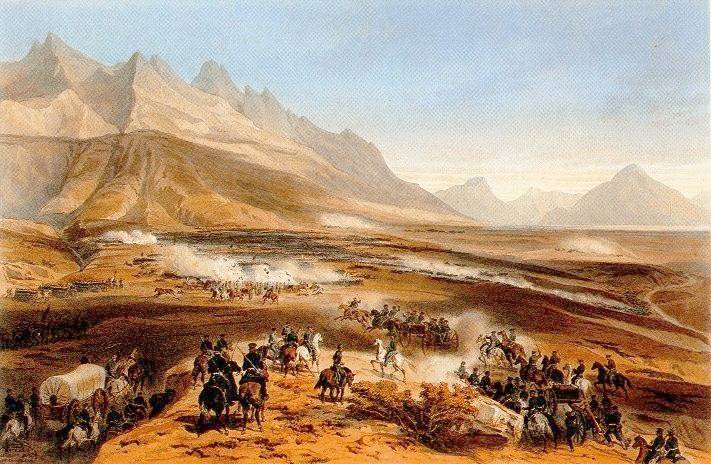
BATTLE OF BUENA VISTA
View of the moment witnessed by Capt. James H. Carleton "when O'Brien was so gallantly striving to hold the Mexicans in check during their last attack upon the great plateau." It occurred while the Kentucky and Illinois infantry were meeting with disaster in the ravine (depicted by the thin strip of smoke, middle right). A large mass of attacking Mexican infantry (center, in distance) threatens Gen. Taylor and his staff (foreground). Nothing stands between them but a battery of three guns under Capt. John P. O'Brien (center). Another gun, commanded by Capt. Braxton Bragg, has just arrived in the right foreground. At far left is Col. Jefferson Davis' 1st Mississippi Infantry and Gen. Joseph Lane with the 3rd Indiana and remnants of the 2nd Indiana rushing to the weak point.
O'Brien saw that if he stood his ground and fought until his guns were captured there was a chance remaining to retrieve the fortunes of the day. By the time he was captured, nearly all of his battery had been killed or wounded. But, they hung on long enough: Bragg, Davis and Lane and their troops arrived to repel the last Mexican assault. During the night the Mexican army retreated down the valley to the south. Taylor reported 272 killed and 387 wounded. The Mexican losses were estimated at double that number. The battle left the Americans in control of Northern Mexico.
Major-General Zachary Taylor, at Agua Nueva, Mexico, to William L. Marcy, Secretary of War, at Washington, D.C. Dispatch communicating Taylor's official report of the Battle of Buena Vista. Headquarters, Army of Occupation, Agua Nueva, March 6th, 1847.
TO THE HON. SECRETARY OF WAR:
Sir: - I have the honor to submit a detailed report of the operations of the forces under my command, which resulted in the engagement of Buena Vista, the repulse of the Mexican army, and the reoccupation of this position.
About eight o'clock, a strong demonstration was made against the centre of our position, a heavy column moving along the road. This forces was soon dispersed by a few rapid and well-directed shots from Captain Washington's battery.
In order to bring his men within effective range, General Lane ordered the artillery and Second Indiana regiment forward. The artillery advanced within musket-range of it with great effect, but without being able to check its advance. The infantry ordered to its support had fallen back in disorder, being exposed, as well as the battery, not only to a severe fire of small-arms from the front, but also to a murderous cross-fire of grape and canister, from a Mexican battery on the left. Captain O'Brien found it impossible to retain his position without support, but was only able to withdraw two of his pieces, all the horses and cannoneers of the third piece being killed or disabled.
The batteries of Captains Sherman and Bragg were in position on the plateau, and did much execution, not only in front, but particularly upon the masses which had gained our rear.
The moment was most critical. Captain O'Brien, with two pieces, had sustained this heavy charge to the last and was finally obliged to leave his guns on the field - his infantry support being entirely routed. Captain Bragg, who had just arrived from the left, was ordered at once into battery. Without any infantry to support him, and at the imminent risk of losing his guns, this officer came rapidly into action, the Mexican line being but a few yards from the muzzle of his pieces. The first discharge of canister caused the enemy to hesitate; the second and third drove him back in disorder and saved the day. The Second Kentucky regiment, which had advanced beyond supporting distance in this affair, was driven back and closely pressed by the enemy's cavalry. Taking a ravine which led in the direction of Captain Washington's battery, their pursuers became exposed to his fire, which soon checked and drove them back with loss. In the mean time the rest of our artillery had taken position on the plateau, covered by the Mississippi and Third Indiana regiments, the former of which had reached the ground in time to pour a fire into the right flank of the enemy, and thus contribute to his repulse.
The services of the light artillery, always conspicuous, were more than usually distinguished. Moving rapidly over the roughest ground, it was always in action at the right place and the right time, and its well-directed fire dealt destruction in the masses of the enemy. While I recommend to particular favor the gallant conduct and valuable services of Major Munroe, chief of artillery, and Captains Washington, Fourth artillery, and Sherman and Bragg, Third artillery, commanding batteries, I deem it no more than just to mention all the subaltern officers. They were nearly all detached at different times, and in every situation exhibited conspicuous skill and gallantry. Captain O'Brien, Lieutenants Brent, Whiting, and Couch, Fourth artillery, and Bryan, topographical engineers, (slightly wounded,) were attached to Captain Washington's battery. Lieutenants Thomas, Reynolds, and French, Third artillery, (severely wounded,) to that of Captain Sherman; and Captain Shover and Lieutenant Donaldson, First artillery, rendered gallant and important service in repulsing the cavalry of General Minon.
